So, with the help of my peers, I put together this explication of the science fundamentals that are most helpful for making sense of the world. With a grasp of these basics, a person should be able to more critically evaluate the science they see in the media and politics. I tried to be comprehensive and to make it as clear and simple as possible, but if you think I could explain something better, or I missed a key point, let me know and I'll change it or add something else.
1. Our place in the Universe
The universe is big and old. It started with the big bang about 13.8 billion years ago, and it appears to be infinitely large.
The sun and planets formed about 4.6 billion years ago. A small planet called Theia crashed into the early earth, and debris from the crash coalesced to form the moon. (The picture below is an artist's rendition of what the collision might have looked like.)
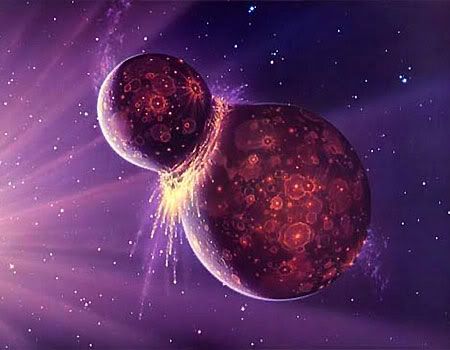
The sun is much bigger than the earth, and the earth orbits around the sun at a distance of ~93 million miles. It takes one year for the earth to do a complete lap around the sun.
The earth spins on its own axis every 24 hours, causing day and night. From a perspective above the north pole the earth spins counterclockwise, which is why the sun and other celestial bodies appear to rise in the East and set in the West.
The earth is much bigger than the moon, and the moon orbits the earth at a distance of ~250 thousand miles. It takes 28 days for the moon to do complete lap around the earth, corresponding with the time it takes to go from one "full moon" to the next. The moon turns slowly as it orbits, such that the same side of the moon always faces the earth. Only a few astronauts have seen the side that faces away from us, which is misleadingly called the "dark" side.
Tides are mainly caused by the moon’s gravity, although the sun's gravity has a slight effect, too. There are TWO tide cycles per day, because at any one time there’s a high tide bulge on the side of the earth facing the moon AND on the exact opposite side.
The North Star is NOT the brightest star in the night sky, and it’s never directly overhead unless you’re standing on the North Pole. The best way to find it is by following an imaginary line up from the two stars on the business end of the big dipper’s spoon. The north star is part of the "little dipper" but you usually can't see the little dipper, which is faint, because of urban light pollution.
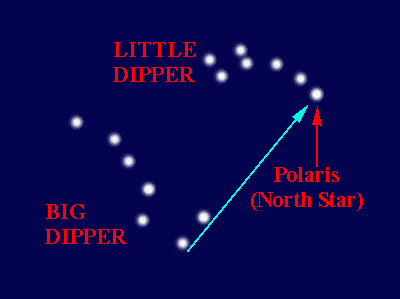
The earth is colder near the poles than near the equator, since the curvature of the earth means sunlight hits the poles at a less direct angle. The greater heating near the equator is also what drives atmospheric circulation (wind), which helps distribute the heat a bit more evenly.
Seasons are NOT caused by the earth moving closer or further from the sun. The real reason seasons happen is because the earth’s axis of rotation is tilted with respect to the plane of its orbit around the sun. So, depending on what point the earth is at in its annual orbit, either the northern or the southern hemisphere is more exposed to direct sunlight. The northern hemisphere is most angled towards the light in June (our summer), and the southern hemisphere is most angled towards the light in December (their summer).
About 5 billion years from now the sun will grow into a "red giant" star and will destroy the earth. Intelligent life may be able to escape in space ships and colonize a younger solar system. They should be able to repeat this nomadic routine for quite a while, but according to the “Big Freeze” hypothesis, the ever-expanding universe will eventually become too spread-out, burnt-out, and cold to have any stars or life. That may seem depressing, but it's kind of silly to worry about something so incredibly far in the future.
2. Basic Science
Energy comes in different forms, like movement, heat, light, electricity, magnetism, radiation, and chemical bonds. Energy can change between forms but it can't be created from nothing. It also can't be destroyed, but it can easily be "lost" if it changes into an unusable form, like when a fire finishes burning and the warmth diffuses away over a broad area.
When we change energy from one form to another some of the energy always escapes in unusable forms, so we can never recapture 100% of the energy we started with. That's why hybrid cars that recharge the battery when you use the brakes still need to be refueled from time to time. And it's why the thing about how they used humans for power in the Matrix movies would never really work.

Sometimes non-scientists talk loosely about different kinds of "energy" that don't really exist. For example, if someone tells you, "microwaving destroys the spiritual energy in broccoli", "the mystic energy of this crystal amplifies your chi", or "the magnetic energy in this headband will re-align your chakras and suppress the negative brainwaves that are making you depressed," it's almost certainly bullshit that has nothing to do with real science.
Pretty much everything is made of atoms; sturdy little particles that are hard to divide into anything smaller. There are about 117 unique kinds of atom, each constituting a unique "element", like gold, helium, sulfur, or oxygen.
Nuclear reactions are when you disrupt the core of an atom, turning it into a different element and releasing insane amounts of energy. Atoms that are easily disrupted comprise the "radioactive" elements like Uranium and Plutonium.
Molecules are stuck-together combinations of multiple atoms from the same or different types of elements. Water is a simple molecule made of just three atoms: 2 Hydrogens (H) stuck to one Oxygen (O), hence the name "H20".
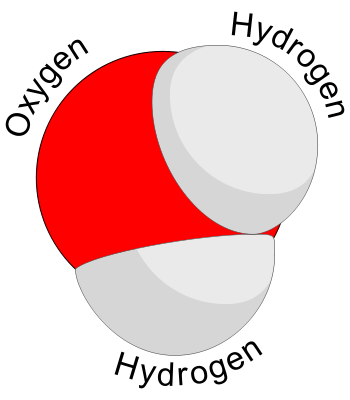
Molecules can have properties that are totally different from those of the individual atoms they contain. For example, H and O are both gasses at room temperature, but H20 is a liquid.
Molecules can also be very complicated, like a DNA molecule, which has thousands of atoms in a fancy arrangement. (The D, the N, and the A don't stand for individual atoms- The molecule naming system is different for big molecules.)
The best atom for forming complex molecules is carbon, because it can connect to multiple other atoms in lots of different ways. The special molecules found in living things contain a lot of carbon atoms.
Air is about 78% Nitrogen molecules (N2) and 20% Oxygen molecules (O2), with some other molecules like Carbon Dioxide (CO2) and ozone (O3) in relatively small amounts. Oxygen is the part we absorb when we breathe, and Nitrogen is just filler, basically.
The ozone layer is a part of the upper atmosphere that blocks a lot of the invisible ultraviolet (UV) light from the sun. If that UV reached the earth it would cause cancer, sunburn, mutations, and other bad stuff. Some man-made chemicals called chloro-fluoro-carbons (CFCs), which were used in refridgerators, styrofoam, hairspray, and other things, were found to be destroying the ozone. We banned the chemicals, but there is still a hole in the ozone layer over Antarctica, where circulating winds concentrated the CFCs. The ozone problem and global warming are separate issues that should not be confused as the same thing.
Sound can travel through solid, liquid, or gas, but it can’t travel through the vacuum of space, because there are no molecules in a vacuum to pass along the vibrations of sound. So all the thundering spaceships, explosions, and laser "beuu beuu!"s that you hear in Star Wars would actually be utter silence if it was real.
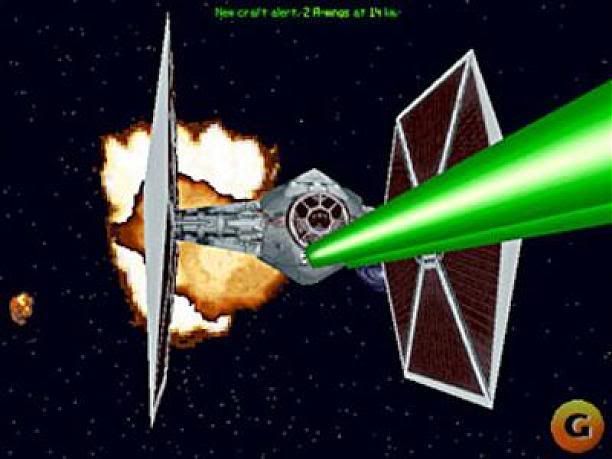
3. Nature and life on Earth
Evolution by natural selection is not just a theory. Everything about it has been convincingly proven over 150 years of research, and it has earned its place as the basis of all modern biology and medicine. Scientists continue to discover new details about evolution, but there is no controversy within the scientific community that evolution is real. There's a good explanation of how evolution works here.
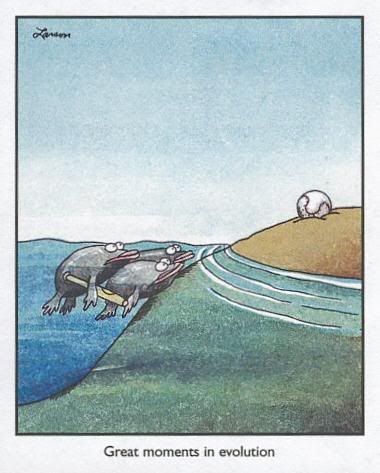
It is possible to believe in evolution and still believe in God, providing you are willing to take some parts of the Bible metaphorically. Unfortunately, religious fundamentalists see evolution as a threat to their beliefs and are promoting a fake theory called "Intelligent Design" (ID) to interfere with the teaching of evolution. Unlike evolution, ID is not supported by the evidence and has no chance of leading to useful discoveries in biology and medicine. It's totally necessary to include evolution in school biology curricula, and it's totally riduculous and counterproductive to include ID.
Life probably formed from naturally-occurring, carbon-based molecules soon after the earth was cool enough for oceans. We don't know how common it is for life to arise from non-living chemicals, but obviously it happened on at least one planet in the universe, because here we are.
The first life was probably a chain of molecules that could assemble a copy of itself by linking loose molecules in the environment into an identical chain, and then that chain would make a copy of itself, and so on. That would be similar to how the genetic material in all life today (DNA and RNA) copies itself. It's like one strand of a zipper being a template for forming the corresponding strand from loose zipper bits.
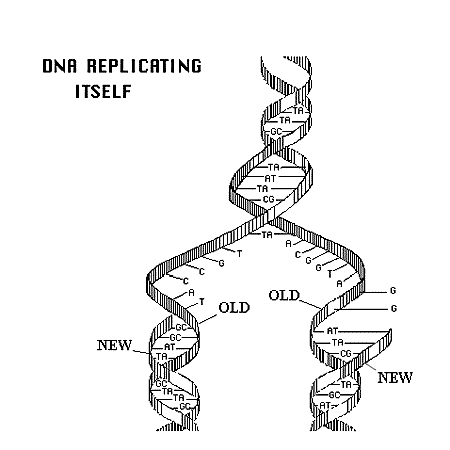
Not long after scientists learned that DNA worked like a zipper with matching halves, they invented a way to make unlimited copies of DNA in a test tube. It's called "PCR", which stands for Polymerase Chain Reaction. PCR is what they do when they need to amplify traces of DNA from a crime scene so that they have enough copies to analyze.
Every cell in your body has all the DNA information needed to make an exact clone of you, except for your sperm cells (if you're a guy) or your unfertilized egg cells (if you're a girl). Sperm and eggs cells only have half the DNA needed to make a person, so they need to combine to be viable. It's the same way with everything that has sex, even plants. Pollen is plant sperm.
There’s fossil evidence of bacteria from about 3.5 billion years ago, which fits with DNA-based estimates of when all life traced back to one primitive species. So the common ancestor of everything (trees, jellyfish, people, etc.) was a primitive bacteria.
Every known species on earth has a two-part scientific name in the form Genus species. The first part is more general (i.e. it can be the same for more than one species), hence "Genus", and the second part is more specific, hence species. Genus is always capitalized, species is never capitalized, and both parts are always italicized. People are Homo sapiens, which means "Human, modern" in Latin. We are the only living species in the genus Homo, but some of the extinct relatives and predecessors that we know from fossils are also in Homo. For example, Homo erectus, which means "Human, erect" in Latin. Huh huh huh...
The big steps in early evolution were about 3 billion years ago when life gained the ability to get energy from the sun (photosynthesis), about 2 billion years ago when complex cells like amoebas evolved from simple cells like bacteria, about 1 billion years ago when the first multi-celled organisms evolved, about 500 million years ago when fancy invertebrates started to flourish, about 365 million years ago when the first fish crawled onto the land, about 65 million years ago when the dinosaurs died out, about 7 million years ago when the ancestors of humans split off from the rest of the apes, and about 200 thousand years ago when anatomically modern humans arose.
A gene is a section of DNA that has the code to make a particular protein molecule. Protein molecules are the molecules that actually do stuff inside cells. They're like the gears and levers of a machine.
Genes are mostly the same from one person to another. However, different individuals have slightly different versions of the same genes, which means their proteins are slightly different, which can affect things like how tall they grow, what color their eyes are, whether they are susceptible to certain genetic disorders, etc. One of the nice things about sex is that when you shuffle your genes with your partner's genes, your offspring have a chance to get the best versions of the genes from each parent. Of course, they have an equal chance of getting the worst versions of the genes from each parent. So if you don't like the way your first kid turned out, have some more until you hit that perfect mix of genes. Just kidding.
The sun is by far the most abundant source of energy on earth, but plants are the only organisms that can harness its energy, through a process called "photosynthesis". If you're not a plant you can't do photosynthesis, so you have to get your energy by eating plants, or by eating animals that ate plants somewhere down the line.
The special, green molecule that plants use to catch the sun's energy is called chlorophyll. With the energy caught by chlorophyll, plants merge carbon dioxide and water into big molecules called carbohydrates. Carbohydrates store the sun's energy until the plant needs it later.
Besides the fact that plants are ultimately our only source of food, they are also important because they take up carbon dioxide (a harmful greenhouse gas) and give off oxygen (the gas we need to breathe). Humans and other animals give off carbon dioxide when we breathe out, which gives back to the plants and completes the cycle.
When a living thing dies and rots, the complex molecules in its body are broken back down into carbon dioxide (CO2) and other small molecules. But when a living thing dies and is buried in a way that it can't completely rot, the complex molecules in its body can eventually turn into fossil fuel; oil, gas, or coal. When you dig up fossil fuel and burn it, you are releasing the energy that the ancient life gathered from the sun, all those years ago, and releasing CO2 in the process.

The bad things about burning fossil fuel are: 1) We're using it MUCH faster than it forms, so we're going to run out in a couple hundred years, tops. 2) It doesn't just release the energy from the fossil plants and animals- it also releases the material of their bodies into the atmosphere in the form of carbon dioxide (CO2) and other pollutants. That excess CO2 changes the properties of the atmosphere and the oceans, making the planet retain more heat (global warming) and the ocean become more acidic (ocean acidification).
Another thing that puts excess CO2 into the air is cutting down and burning forests, because the trees store lot of carbon in their bodies that gets let out as CO2 when they burn or rot.
There are a lot of things that affect climate and weather besides the excess CO2 humans are putting into the atmosphere, and historically there have been a lot of ups and downs in global temperatures, like the ice ages. Scientists are studying ALL the natural things that affect climate and weather, everything from solar cycles and ocean currents to continental drift and volcanic dust in the atmosphere, and they keep finding that the temperature changes seen in the last 150 years can't be explained by those things alone. However, when they account for the warming effect of the excess CO2 that humans have put in the atmosphere, the recent temperature changes make total sense. So, humans aren't the ONLY thing that's affecting the climate, but we ARE affecting the climate, and if we keep putting out CO2, global warming is going to increase to the point that it's impossible to deny. Of course, by then it will be too late to avoid the negative consequences.
Nutrients like nitrogen and phosphorus are essential for all life, because they are needed to make molecules like protein and DNA. But too much nutrients are bad for the environment because they stimulate noxious algae, weeds, and germs, which smother out the more desirable forms of life. Man-made fertilizer and sewage are the main sources of excessive nutrients getting into the environment.
No matter where you are on land you are in a "watershed"; an area of land that drains into a particular body of water. An example would be the watershed for the Mississippi River, which covers a huge portion of the central US. Any rain that falls there will eventually run down to the Mississippi, carrying with it whatever dirt or pollution it sweeps off the land.
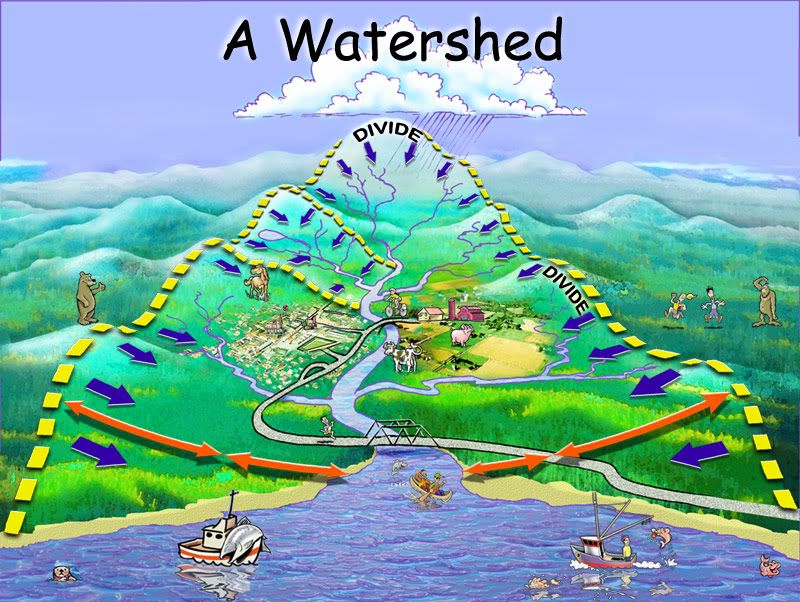
What the land is like in a watershed determines whether or not the water it leads to is clean or murky. Generally, the more human development there is in a watershed, the more polluted the water is, and the more forests and wetlands there are, the less polluted the water is. However, if the development in a watershed is organized in the right ways, minimizing the area of pavement, rooftops, and chemically-treated lawns, and leaving as much lush vegetation as possible in the buffer zones around streams and shorelines, the pollution can be somewhat reduced.
Watersheds with lots of vegetation also help catch rain and percolate it slowly into the groundwater, reducing the effects of floods and droughts and insuring a steady water supply for drinking. In some places, rivers no longer flow year-round because so much of the forests in the watershed have been cut down.
Both on land and in the water, large predators have been reduced to a tiny fraction of their former abundance by hunting, fishing, and loss of habitat. I.e. there are only a few percent of the lions, tigers, bears, sharks, groupers, tuna, and swordfish that there used to be. Because the predators were connected to everything else through the food chain, their absence has caused huge ripple effects known as "trophic cascades". The trophic cascades have messed up all of earth's natural ecosystems. It's especially bad in the oceans, where trophic cascades caused by overfishing are causing coral reefs to die, clear waters to become murky, jellyfish to take over, and other problems. A lot of things that we thought were just caused by pollution turned out to also trace back to trophic cascades from the loss of predators.
Over a generation or two, people sort-of get used to how messed up the planet is and forget how much better the environment was in the past. I.e. you may notice that the spot you snorkel doesn't have as many fish and live corals as it did when you were a kid, but you are unaware that when your grandpa was a kid, it was even better, and before Columbus came to the Caribbean it was even better than that, with thousands of sea turtles and manta rays and whale sharks and monk seals swimming all over the place! That sad phenomenon of not knowing what you're missing when it comes to the environment is called "shifting baselines".
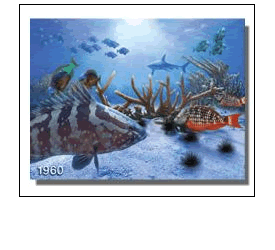
Besides loss of habitat, pollution, and climate change, a big threat to nature is from "invasive species". Invasive species, also known as "exotic" or "alien" species, are species that humans bring into an area that didn't previously have them, then the invaders get loose and multiply, messing up the ecosystem and making native species go extinct. One of the reasons the invaders sometimes take over is because they don't have any natural enemies in their new habitat. Of course, when people introduce their natural enemies, sometimes the natural enemies become even worse invaders than the originals.
To have a multi-cellular organism like a plant or animal, the individual cells in that organism have to cooperate and refrain from reproducing themselves more than is necessary for the good of the whole organism. Usually the cells are cool with that, because they all have the same exact DNA and they know that by doing their individual jobs they are helping the whole organism survive and reproduce to pass on that DNA. But sometimes cells mutate and decide to "Go Rogue" like Sarah Palin. That's what causes cancer; when some of your cells decide to selfishly reproduce themselves (making tumors and stuff) instead of cooperating nicely with the rest of your body.
Animal populations grow faster and faster until something stops them from growing any more, like running out of food and space or getting killed off by plagues or predators. The human population was kept low that way for thousands of years, until science and technology gave us ways to make more food, kill our predators, and reduce the spread of diseases. Since then our population has grown riduculously fast (see graph), but we are now reaching the limit where even with our science and technology the earth is not going to be able to support many more people. So we have a choice of acting like stupid animals and letting our population be controlled by starvation, disease, and fighting, or we can act like wisely and slow our reproduction and consumption down before we run out of resources.
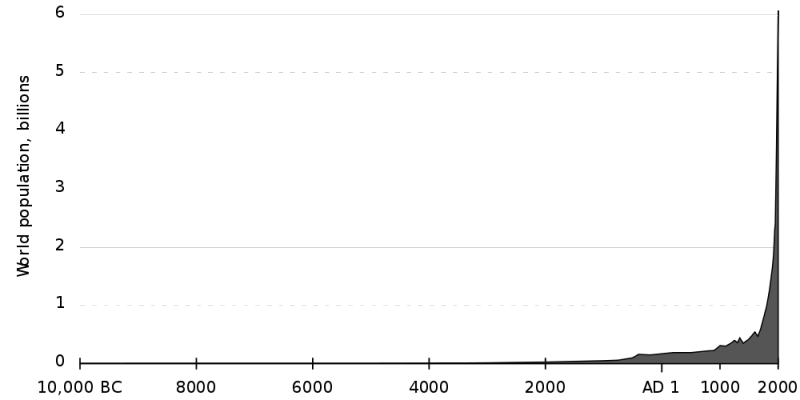
Ok, that's it for now. I'm just going to go ahead and post this, and I'll spruce it up with some pictures and additional entries and stuff later.
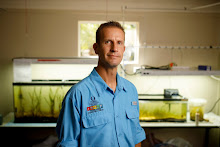
5 comments:
Hey, great Cliff's Notes. The wind must not have been blowing. We need it to blow less often so as to bring out your eclectic side.
James,
I thought Tie Fighters made a Peeyew! sound. Don't tell me I had it wrong all these years!
-Ian
Dad- Thanks. The wind has returned now so I'll put away my eclectic side for a while.
Ian- Nope, no noise in space. Sorry to disappoint! :) In 2001 A Space Odyssey the moviemakers are more faithful about portraying the absence of sound.
I don't think the cliff notes contain all the answers to the pre-test. Would you post the answers? An inquiring windsurfer wants to check up on his knowledge (or lack of it)!
Hey Alex,
Thanks for asking. I just checked the science test and realized there was a typo in the "list things in order of size" problem. I fixed that, and also added an answer key. How did you do?
http://drdouglass.blogspot.com/2013/12/basic-college-science-and-math-pre-test.html
-James
Post a Comment